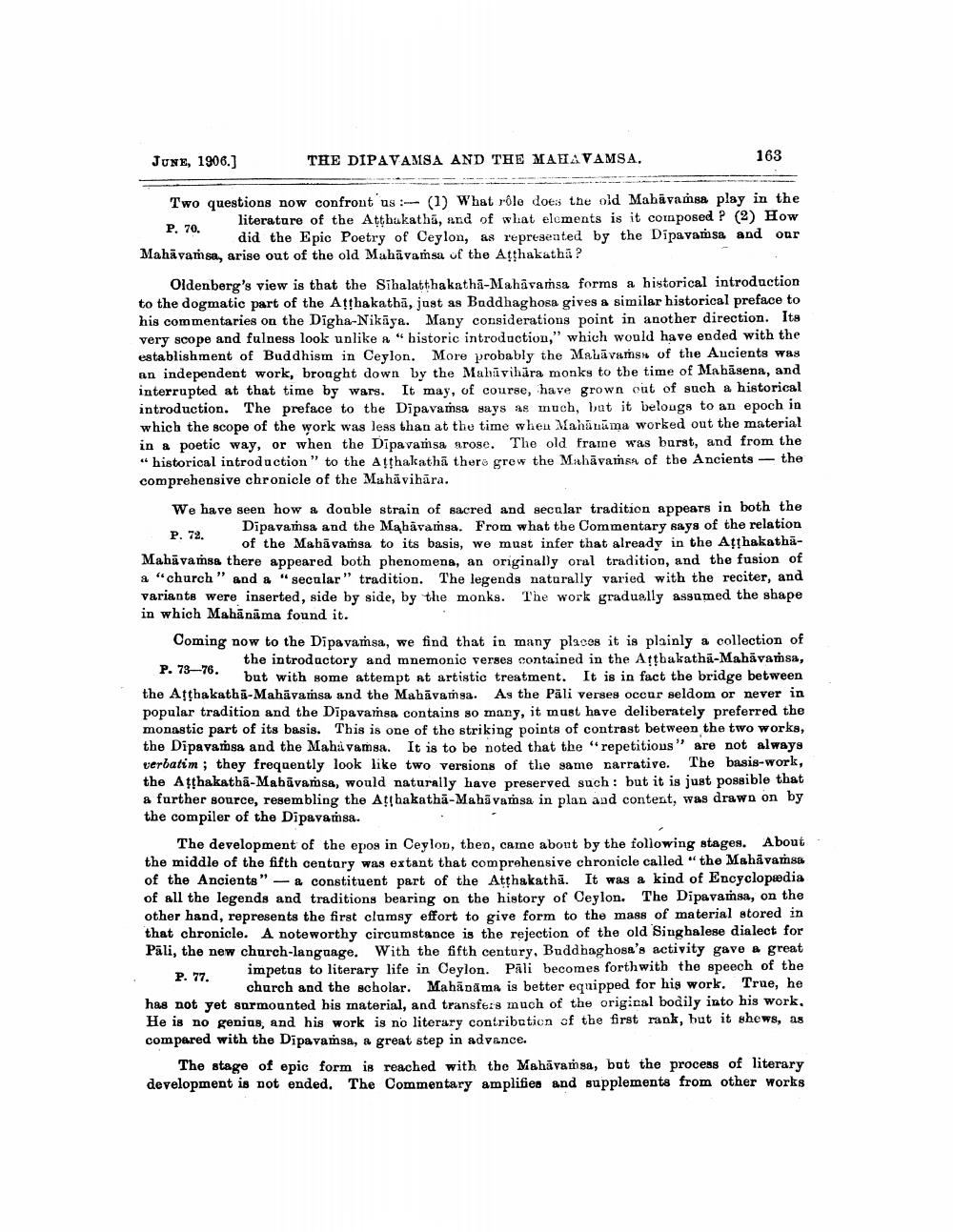________________
JUNE, 1906.]
THE DIPAVAMSA AND THE MAHAVAMSA.
163
Two questions now confront us :--- (1) What rôle does the old Mahavamsa play in the literature of the Aṭṭhakatha, and of what elements is it composed? (2) How P. 70. did the Epic Poetry of Ceylon, as represented by the Dipavamsa and our
Mahāvamsa, arise out of the old Mahavamsa of the Aṭṭhakatha?
Oldenberg's view is that the Sihalaṭṭhakatha-Mahavamsa forms a historical introduction to the dogmatic part of the Atthakatha, just as Buddhaghosa gives a similar historical preface to his commentaries on the Digha-Nikaya. Many considerations point in another direction. Its very scope and fulness look unlike a "historic introduction," which would have ended with the establishment of Buddhism in Ceylon. More probably the Malavams of the Aucients was an independent work, brought down by the Mahavihara monks to the time of Mahasena, and interrupted at that time by wars. It may, of course, have grown out of such a historical introduction. The preface to the Dipavamsa says as much, but it belongs to an epoch in which the scope of the work was less than at the time when Mahanama worked out the material in a poetic way, or when the Dipavamsa arose. The old frame was burst, and from the "historical introduction" to the Atthakatha there grew the Mahavams of the Ancients comprehensive chronicle of the Mahavihara.
the
We have seen how a double strain of sacred and secular tradition appears in both the Dipavamsa and the Mahavamsa. From what the Commentary says of the relation P. 72. of the Mahavamsa to its basis, we must infer that already in the AṭṭhakathaMahāvamsa there appeared both phenomena, an originally oral tradition, and the fusion of a "church" and a "secular" tradition. The legends naturally varied with the reciter, and variants were inserted, side by side, by the monks. The work gradually assumed the shape in which Mahanama found it.
Coming now to the Dipavamsa, we find that in many places it is plainly a collection of the introductory and mnemonic verses contained in the Atthakatha-Mahavaṁsa, P. 73-76. but with some attempt at artistic treatment. It is in fact the bridge between the Atthakatha-Mahāvamsa and the Mahavamsa. As the Päli verses occur seldom or never in popular tradition and the Dipavamsa contains so many, it must have deliberately preferred the monastic part of its basis. This is one of the striking points of contrast between the two works, the Dipavamsa and the Mahavamsa. It is to be noted that the "repetitions" are not always verbatim; they frequently look like two versions of the same narrative. The basis-work, the Aṭṭhakatha-Mahāvamsa, would naturally have preserved such: but it is just possible that a further source, resembling the Athakatha-Mahāvamsa in plan and content, was drawn on by the compiler of the Dipavamsa.
The development of the epos in Ceylon, then, came about by the following stages. About the middle of the fifth century was extant that comprehensive chronicle called "the Mahavamsa of the Ancients"-a constituent part of the Atthakatha. It was a kind of Encyclopædia of all the legends and traditions bearing on the history of Ceylon. The Dipavamsa, on the other hand, represents the first clumsy effort to give form to the mass of material stored in that chronicle. A noteworthy circumstance is the rejection of the old Singhalese dialect for Pali, the new church-language. With the fifth century, Buddhaghosa's activity gave a great impetus to literary life in Ceylon. Pali becomes forthwith the speech of the P. 77. church and the scholar. Mahānāma is better equipped for his work. True, he has not yet surmounted his material, and transfers much of the original bodily into his work. He is no genius, and his work is no literary contribution of the first rank, but it shews, as compared with the Dipavamsa, a great step in advance.
The stage of epic form is reached with the Mahavamsa, but the process of literary development is not ended. The Commentary amplifies and supplements from other works




